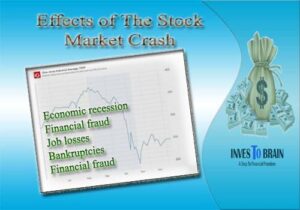Why did the stock market crash and what caused the Wall Street crash of 1929?
The stock market crash of 1929, also known as the Wall Street Crash, was one of the most devastating events in the history of the US economy. There were several factors that contributed to the crash, including:
- Speculation and overvalued stocks: In the years leading up to the crash, many investors were buying stocks on margin, meaning they borrowed money to invest in the market. This led to a speculative bubble and overvalued stocks, with prices far exceeding the companies’ actual earnings.
- Unequal distribution of wealth: The 1920s was a time of great prosperity for some, but many Americans were left behind, with little or no access to the booming economy. This unequal distribution of wealth meant that there was not enough buying power to sustain the high stock prices.
- Agricultural depression: The agricultural sector had been struggling throughout the 1920s, with falling prices and overproduction leading to an agricultural depression. This had a ripple effect on the rest of the economy, with farmers and rural communities struggling to make ends meet.
- Black Tuesday: On October 24, 1929, a record number of shares were traded on the New York Stock Exchange, leading to panic among investors. This was followed by a massive sell-off on October 29, 1929, which became known as Black Tuesday. The stock market lost more than 20% of its value in a single day, leading to widespread panic and the beginning of the Great Depression.
These factors all contributed to the stock market crash of 1929, which had far-reaching economic and social consequences for the United States and the world.
Please continue writing.
The crash of 1929 led to a period of economic turmoil and hardship that lasted for several years. The effects of the crash were felt not only in the United States but also around the world, as the country’s financial system was tightly linked to those of other nations.
The crash had a domino effect on the economy, leading to a sharp decrease in consumer spending, investment, and industrial production. Unemployment skyrocketed, and businesses struggled to stay afloat, which further weakened the economy. Banks failed, and many people lost their savings and investments.
In response to the crisis, President Franklin D. Roosevelt introduced the New Deal, a series of economic policies and programs aimed at stabilizing the economy and providing relief to those who were suffering. The New Deal included measures such as the creation of the Social Security system, the establishment of the Federal Deposit Insurance Corporation (FDIC) to protect depositors’ savings, and the National Industrial Recovery Act, which aimed to stimulate industrial production and create jobs.
Despite these efforts, the United States did not fully recover from the effects of the crash until the onset of World War II, which led to a significant increase in industrial production and employment.
In conclusion, the Wall Street crash of 1929 was caused by a combination of factors, including speculation, overvalued stocks, unequal distribution of wealth, and agricultural depression. The crash had far-reaching economic and social consequences and led to the Great Depression, which lasted for several years. The lessons learned from this event have helped shape the way financial markets are regulated and monitored today.
Please continue writing.
The crash of 1929 and the ensuing Great Depression had a profound impact on the way Americans viewed the role of government in their lives. The New Deal and its various programs represented a significant shift in the way government interacted with its citizens and provided a safety net for those in need.
The Securities Act of 1933 and the Securities Exchange Act of 1934 were two pieces of legislation passed in response to the crash, aimed at regulating the securities industry and restoring investor confidence in the markets. The creation of the Securities and Exchange Commission (SEC) provided oversight and enforcement of these regulations.
The lessons learned from the crash also led to the development of new economic theories and models, including Keynesian economics, which emphasized government intervention to stabilize the economy during times of crisis.
In conclusion, the Wall Street crash of 1929 was a pivotal moment in US history that had far-reaching economic and social consequences. The lessons learned from this event have helped shape the way financial markets are regulated and monitored today and have had a lasting impact on the role of government in the lives of Americans.
Please clarify this
Certainly. The Wall Street crash of 1929 was a major event in US history that had far-reaching consequences for the US and the world. It marked the beginning of the Great Depression, a period of economic hardship and social upheaval that lasted for several years. The crash was caused by a combination of factors, including speculation, overvalued stocks, unequal distribution of wealth, and agricultural depression.
The response to the crash, including the New Deal and the establishment of the SEC, represented a significant shift in the way government interacted with its citizens and the economy. The New Deal programs aimed to provide relief to those who were suffering and stimulate economic growth, while the SEC was tasked with regulating the securities industry and restoring investor confidence in the markets.
The lessons learned from the crash have had a lasting impact on the US and the world, shaping the way financial markets are regulated and monitored and influencing economic theory and policy. The crash of 1929 is an important historical event that provides valuable insights into the causes and consequences of economic crises and the role of government in addressing them.



